The Bonding Mechanism of the Micro-Interface of Polymer Coated Steel
Abstract
:1. Introduction
2. Experiment and Methods
2.1. Sample Preparation
2.2. XPS and SEM
2.3. MD and QM Simulation
2.3.1. PET and the TFS Model
2.3.2. MD and QM Simulation
2.3.3. Interaction Energy Calculation
3. Results and Discussion
3.1. Analysis of the Experimental Results
3.2. Interface Bonding Mechanism
3.2.1. MD and QM Simulation Results
3.2.2. Interaction Energy Calculation
3.2.3. Radial Element Concentration Distribution
3.3. Chromium Oxide Surface with Different Hydroxyl Content
4. Conclusions
Author Contributions
Funding
Conflicts of Interest
References
- Zhang, Q.; Liu, J.; Zhang, B.; Zhang, L. Advances in Theory and Technology for Laminating of Polymer-coated Steel. J. Mech. Eng. 2019, 8, 30–45. [Google Scholar] [CrossRef] [Green Version]
- Morita, S.I.; Iwashita, H.; Tanaka, A. Effect of Contact Cooling Length between the Laminating Rolls on the Biaxial Orientation Changes of Polyester Film in the Laminating Process. J. Surf. Finish. Soc. Jpn. 2001, 52, 517–521. [Google Scholar] [CrossRef]
- Takeshi, S.; Hiroki, I.; Masaaki, Y. The Mechanism of Wet Adhesion of the PET-laminated Steel Sheet. Tetsu-to-Hagane 2003, 89, 142–148. [Google Scholar]
- Cho, C.K.; Kim, J.D.; Cho, K.; Park, C.E.; Lee, S.W.; Ree, M. Effects of the lamination temperature on the properties of poly (ethylene terephthalate-co-isophthalate) in polyester-laminated tin-free steel can—I. Characterization of poly (ethylene terephthalate-co-isophthalate). J. Adhes. Sci. Technol. 2000, 14, 1131–1143. [Google Scholar] [CrossRef]
- Cho, C.K.; Kim, J.D.; Cho, K.; Park, C.E.; Lee, S.W.; Ree, M. Effects of the lamination temperature on the properties of poly (ethylene terephthalate-co-isophthalate) in polyester-laminated tin-free steel can—II. Adhesion mechanism of poly (ethylene terephthalate-co-isophthalate) to TFS. J. Adhes. Sci. Technol. 2000, 14, 1145–1157. [Google Scholar] [CrossRef]
- Ruokolainen, R.B.; Sigler, D.R. The Effect of Adhesion and Tensile Properties on the Formability of Laminated Steels. J. Mater. Eng. Perform. 2008, 17, 330–339. [Google Scholar] [CrossRef]
- Braasch, D.A.; Gillis, M.; Pramanik, M.; Ferguson, R.C. Detection of in Situ Early Corrosion on Polymer-Coated Metal Substrates. ACS Appl. Mater. Interfaces 2019, 11, 37193–37208. [Google Scholar] [CrossRef]
- Iwashita, H.; Morita, S.I.; Tanaka, A. Development of Amorphous Layer of Biaxially Oriented Polyester Film on Laminated Steel in the Laminating Process. Tetsu-to-Hagane 2001, 87, 175–182. [Google Scholar] [CrossRef] [Green Version]
- Terauchi, F.; Iwashita, H.; Tanaka, A.; Morita, S. Effect of Annealing Temperature on Adhesion of Polyester Film to Electrolytically Chromium Coated Steel. Tetsu-to-Hagane 1999, 85, 236–240. [Google Scholar] [CrossRef]
- Matsubayashi, H. Metal Can using Polyester Film Laminated ECCS (Electrolytic chromium/chromium oxide-coated steel). Zairyo-to-Kankyo 2002, 51, 299–304. [Google Scholar] [CrossRef] [Green Version]
- Lindner, M.; Rodler, N.; Jesdinszki, M.; Schmid, M.; Sängerlaub, S. Surface energy of corona treated PP, PE and PET films, its alteration as function of storage time and the effect of various corona dosages on their bond strength after lamination. J. Appl. Polym. Sci. 2018, 135, 45842. [Google Scholar] [CrossRef]
- Liu, J.; Zhang, Q.; Geng, L.; Zhang, B.; Zhang, L. Study on evolution law of lateral thickness difference of Polymer-coated steel in laminating process. Mater. Today Proc. 2020, in press. [Google Scholar] [CrossRef]
- Alexiou, V.F.; Mathioudakis, G.N.; Andrikopoulos, K.S.; Beobide, A.S.; Voyiatzis, G.A. Poly (ethylene Terephthalate) Carbon-Based Nanocomposites: A Crystallization and Molecular Orientation Study. Polymers 2020, 12, 2626. [Google Scholar] [CrossRef] [PubMed]
- Anagri, A.; Baitukha, A.; Debiemme-Chouvy, C.; Lucas, I.T.; Pulpytel, J.; Mai Tran, T.T.; Tabibian, S.; Arefi-Khonsari, F. Nanocomposite coatings based on graphene and siloxane polymers deposited by atmospheric pressure plasma. Application to corrosion protection of steel. Surf. Coat. Technol. 2019, 377, 124928. [Google Scholar] [CrossRef]
- Ubaid, F.; Radwan, A.B.; Naeem, N.; Shakoor, R.A.; Ahmad, Z.; Montemor, M.F.; Kahraman, R.; Abdullah, A.M.; Soliman, A. Multifunctional self-healing polymeric nanocomposite coatings for corrosion inhibition of steels. Surf. Coat. Technol. 2019, 372, 121–133. [Google Scholar] [CrossRef]
- Bosh, N.; Deggelmann, L.; Blattert, C.; Mozaffari, H.; Müller, C. Synthesis and characterization of Halar polymer coating deposited on titanium substrate by electrophoretic deposition process. Surf. Coat. Technol. 2018, 347, 369–378. [Google Scholar]
- Valega Mackenzie, F.O.; Thijsse, B.J. Study of Metal/Epoxy Interfaces between Epoxy Precursors and Metal Surfaces Using a Newly Developed Reactive Force Field for Alumina–Amine Adhesion. J. Phys. Chem. C 2015, 119, 4796–4804. [Google Scholar] [CrossRef]
- Tanaka, A.; Hanafusa, T.; Kojyo, H.; Inui, T. Adhesion of biaxially oriented polyethylene terephthalate film to tin free steel. Trans. Iron Steel Inst. Jpn. 1987, 27, 638–644. [Google Scholar] [CrossRef] [Green Version]
- Komai, M.; Taniguchi, A.; Shimizu, N.; Shimizu, K.; Tanaka, A. Effects of Composition and Microstructure of Hydrated Chromium Oxide on Adhesive Property of PET/I Film Laminated TFS. Tetsu-to-Hagane 1997, 83, 377–382. [Google Scholar] [CrossRef] [Green Version]
- Zumelzu, E.; Rull, F.; Schmidt, P.; Boettcher, A.A. Structural analysis of polymer-metal laminates by electron microscopy and infrared spectroscopy. Surf. Coat. Int. Part B Coat. Trans. 2006, 89, 57–62. [Google Scholar] [CrossRef]
- Feng, L.; Yang, H.; Wang, F. Experimental and theoretical studies for corrosion inhibition of carbon steel by imidazoline derivative in 5% NaCl saturated Ca(OH)2 solution. Electrochim. Acta 2011, 58, 427–436. [Google Scholar] [CrossRef]
- Chen, S.; Yune, J.H.R.; Zhang, Z.Q.; Liu, Z.; Sridhar, N.; Wu, L.Y.L.; Chng, S.; Liu, J. Multiscale Modeling to Predict the Hydrophobicity of an Experimentally Designed Coating. J. Phys. Chem. C 2020, 124, 9866–9875. [Google Scholar] [CrossRef]
- Poon, J.; Madden, D.C.; Wood, M.H. Surface Chemistry of Almandine Garnet. J. Phys. Chem. C 2020, 124, 5099–5117. [Google Scholar] [CrossRef]
- Bhowmik, R.; Sihn, S.; Varshney, V.; Roy, A.K.; Vernon, J.P. Calculation of specific heat of polymers using molecular dynamics simulations. Polymers 2019, 167, 176–181. [Google Scholar] [CrossRef]
- Cruz-Delgado, V.J.; Ávila-Orta, C.A.; Espinoza-Martinez, A.B.; Mata-Padilla, J.M.; Solis-Rosales, S.G.; Jalbout, A.F.; Medellín-Rodríguez, F.J.; Hsiao, B.S. Carbon nanotube surface-induced crystallization of polyethylene terephthalate (PET). Polymers 2014, 55, 642–650. [Google Scholar] [CrossRef]
- Tinacba, E.J.C.; Isobe, M.; Karahashi, K.; Hamaguchi, S. Molecular dynamics simulation of Si and SiO2 reactive ion etching by fluorine-rich ion species. Surf. Coat. Technol. 2019, 380, 125032. [Google Scholar] [CrossRef]
- Cui, W.; Huang, W.; Hu, B.; Xie, J.; Xiao, Z.; Cai, X.; Wu, K. Investigation of the Effects of Adsorbed Water on Adhesion Energy and Nanostructure of Asphalt and Aggregate Surfaces Based on Molecular Dynamics Simulation. Polymers 2020, 12, 2339. [Google Scholar] [CrossRef]
- Buhl, K.B.; Agergaard, A.H.; Lillethorup, M.; Nikolajsen, J.P.; Pedersen, S.U.; Daasbjerg, K. Polymer Brush Coating and Adhesion Technology at Scale. Polymers 2020, 12, 1475. [Google Scholar] [CrossRef]
- Yang, S.; Shin, H.; Cho, M. Molecular dynamics simulation and finite element analysis on mechanical behavior of oxygen functionalized graphene/polymer nanocomposites. J. Mech. Sci. Technol. 2019, 33, 307–314. [Google Scholar] [CrossRef]
- Bahlakeh, G.; Ramezanzadeh, B.; Saeb, M.R.; Terryn, H.; Ghaffari, M. Corrosion protection properties and interfacial adhesion mechanism of an epoxy/polyamide coating applied on the steel surface decorated with cerium oxide nanofilm: Complementary experimental, molecular dynamics (MD) and first principle quantum mechanics (QM) simulation methods. Appl. Surf. Sci. 2017, 419, 650–669. [Google Scholar] [CrossRef]
- Ta, T.D.; Tieu, A.K.; Zhu, H.; Kosasih, B. Adsorption of normal-alkanes on Fe(110), FeO(110), and Fe2O3(0001): Influence of iron oxide surfaces. J. Phys. Chem. C 2015, 119, 12999–13010. [Google Scholar] [CrossRef]
- Zumelzu, E.; Cabezas, C.; Delgado, F. Performance and degradation analyses of traditional and ECCS canning tinplates in citric-citrate medium. J. Mater. Process. Technol. 2004, 152, 384–388. [Google Scholar] [CrossRef]
- Morita, S.; Iwashita, H.; Tanaka, A.; Terauchi, F. Variations of biaxial orientation of polyester film on laminated steel in the laminating process. Tetsu-to-Hagane 2009, 86, 171–175. [Google Scholar] [CrossRef] [Green Version]
- Liu, Z.; Zeng, K.; Zhao, Y. Polymer-Coated Steel: A green revolution in metal packaging for food and beverage. Packag. J. 2012, 4, 9–15. [Google Scholar]
- Takeshi, S.; Hiroki, I.; Hideki, N.; Toyofumi, W. Development of “Universal brite type E” new film laminated TFS for 18L can and pail can. Mater. Jpn. 2005, 44, 145–147. [Google Scholar]
- Zhang, H. Development and application of electrolytic chromium-coated steel (TFS) new products. South. Iron Steel 2002, 4, 13–16. [Google Scholar]
- Zumelzu, E.; Rull, F.; Boettcher, A.A. Characterization and micro- and ultra-structural analysis of PET-based Co-rolled composite electrolytic chromium coated steel (ECCS). J. Mater. Process. Technol. 2006, 173, 34–39. [Google Scholar] [CrossRef]
- Liang, H.; Xie, F.; Guo, F.; Chen, B.; Luo, F.; Jin, Z. Non-isothermal crystallization behavior of poly(ethyleneterephthalate)/poly (trimethylene terephthalate) blends. Polym. Bull. 2008, 60, 115–127. [Google Scholar] [CrossRef]
- Kim, K.C.; Jang, S.S. Molecular dynamics simulation study on the structural properties of poly (ethyleneterephthalate) under uniaxial extension and thermal shrinkage processes. Curr. Appl. Phys. 2017, 18, 19–26. [Google Scholar]
- Boronat, M.; Lopez-Ausens, T.; Corma, A. The acid-base and redox reactivity of CeO2 nanoparticles: Influence of the hubbard U term in DFT + U studies. Surf. Sci. 2016, 648, 212–219. [Google Scholar] [CrossRef]
- Perdew, J.P.; Ruzsinszky, A.; Csonka, G.I.; Vydrov, O.A.; Scuseria, G.E.; Constantin, L.A.; Zhou, X.; Burke, K. Restoring the Density-Gradient Expansion for Exchange in a GGA for Solid and Surfaces. Phys. Rev. Lett. 2008, 100, 136406. [Google Scholar] [CrossRef] [PubMed] [Green Version]
- Semoto, T.; Tsuji, Y.; Yoshizawa, K. Molecular understanding of the adhesive force between a metal oxide surface and an epoxy resin. J. Phys. Chem. C 2011, 85, 11701–11708. [Google Scholar] [CrossRef]
- Semoto, T.; Tsuji, Y.; Yoshizawa, K. Molecular understanding of the adhesive force between a metal oxide surface and an epoxy resin: Effects of surface water. Bull. Chem. Soc. Jpn. 2012, 85, 672–678. [Google Scholar]
- Bahlakeh, G.; Ghaffari, M.; Saeb, M.R.; Ramezanzadeh, B.; De Proft, F.; Terryn, H. A Close-up of the effect of iron oxide type on the interfacial interaction between epoxy and carbon steel: Combined molecular dynamics simulations and quantum mechanics. Phys. Chem. 2016, 120, 11014–11026. [Google Scholar] [CrossRef]
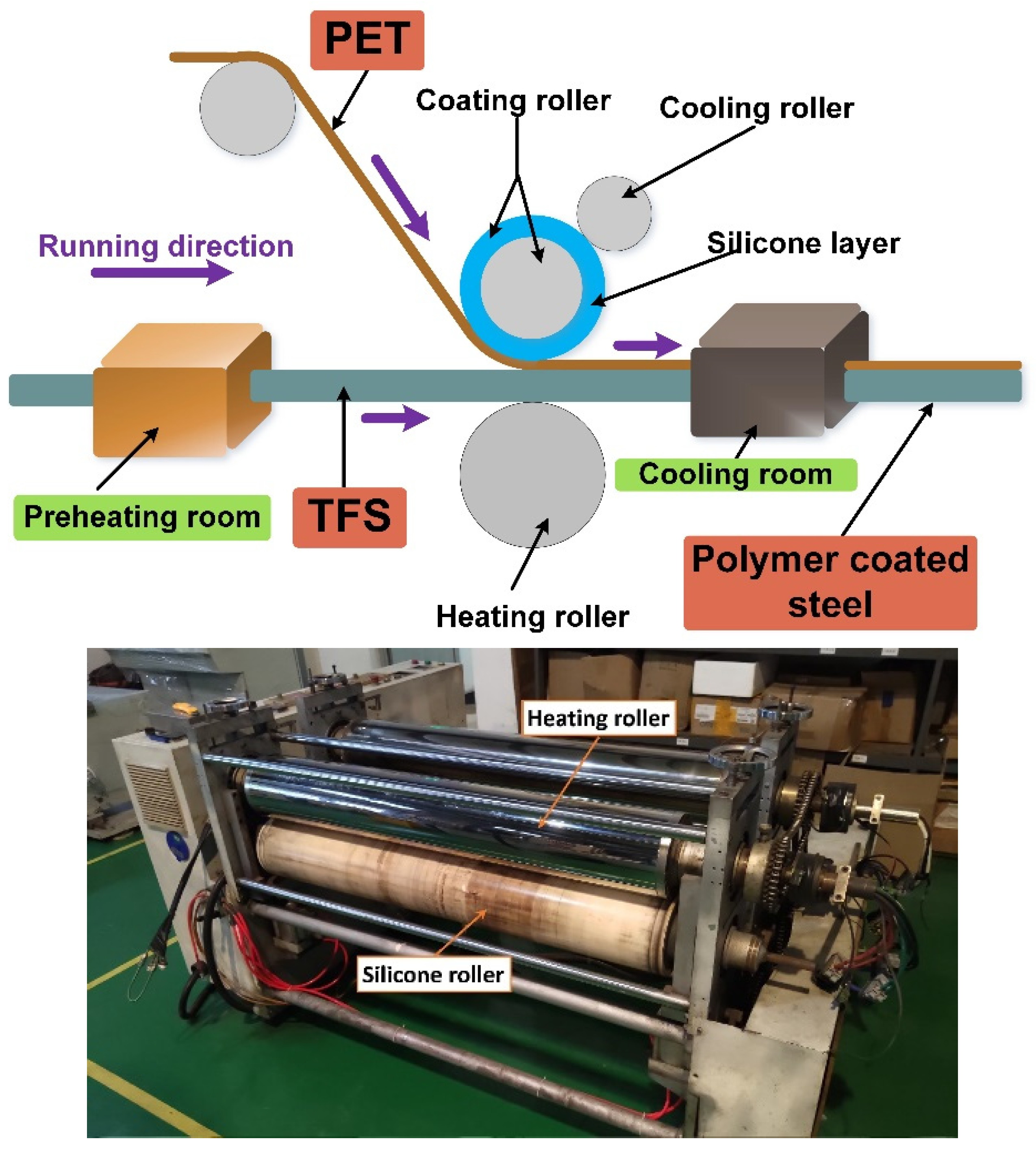




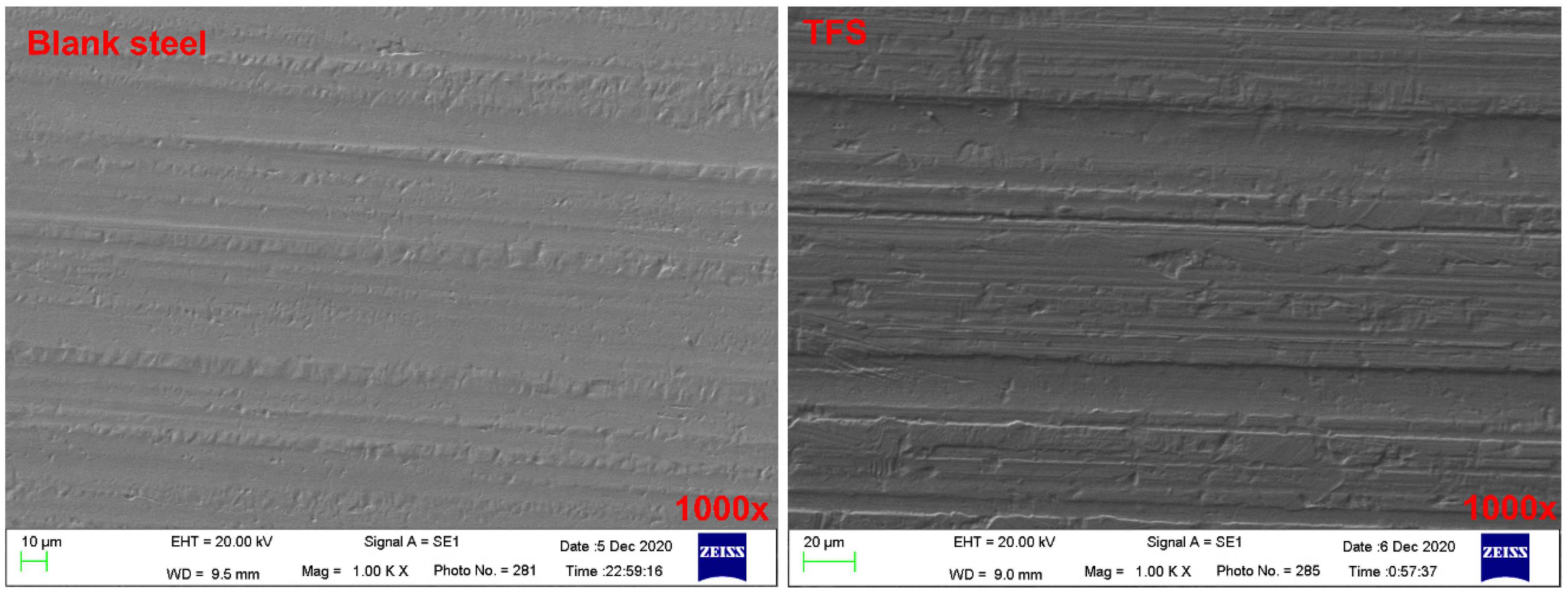
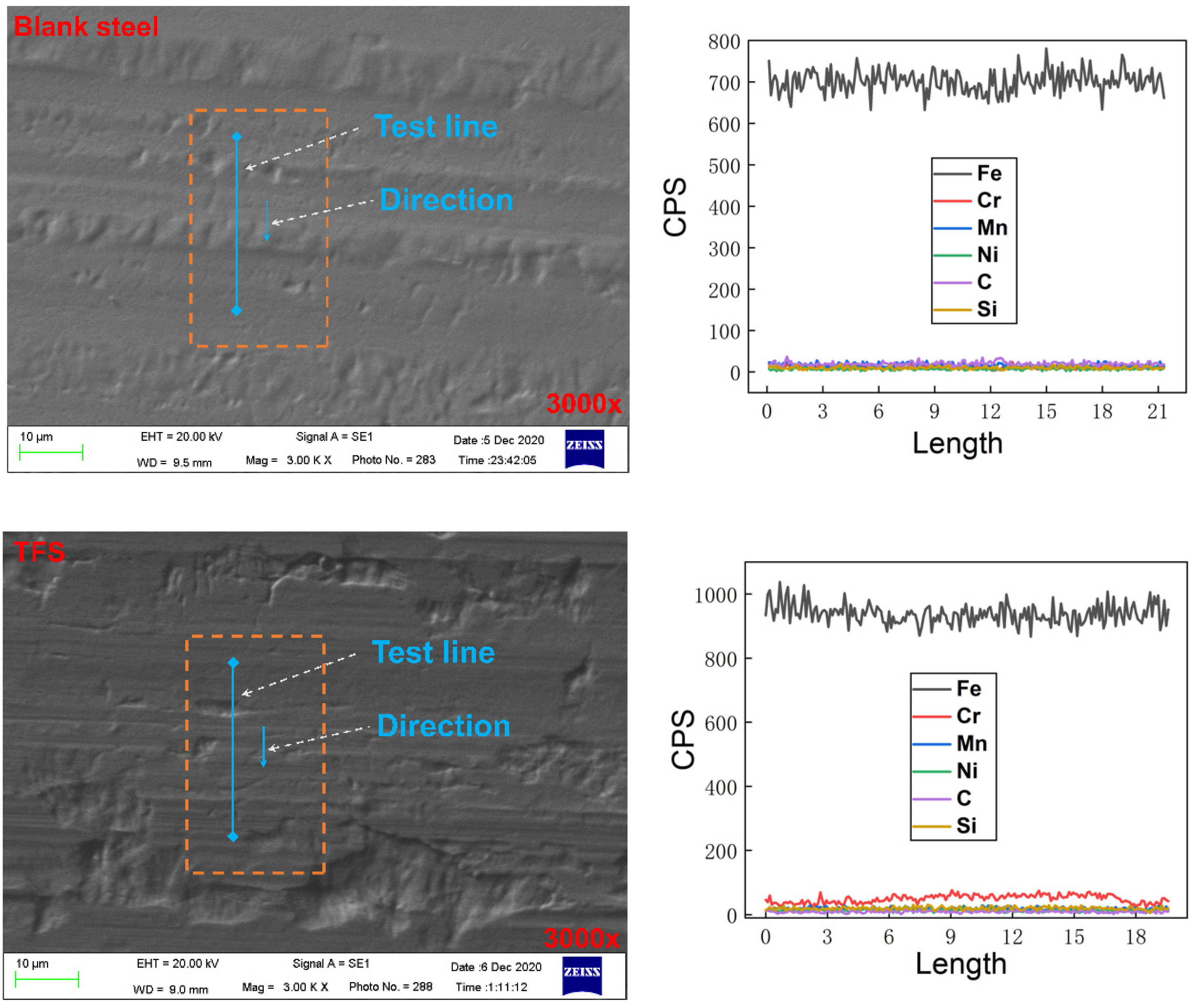

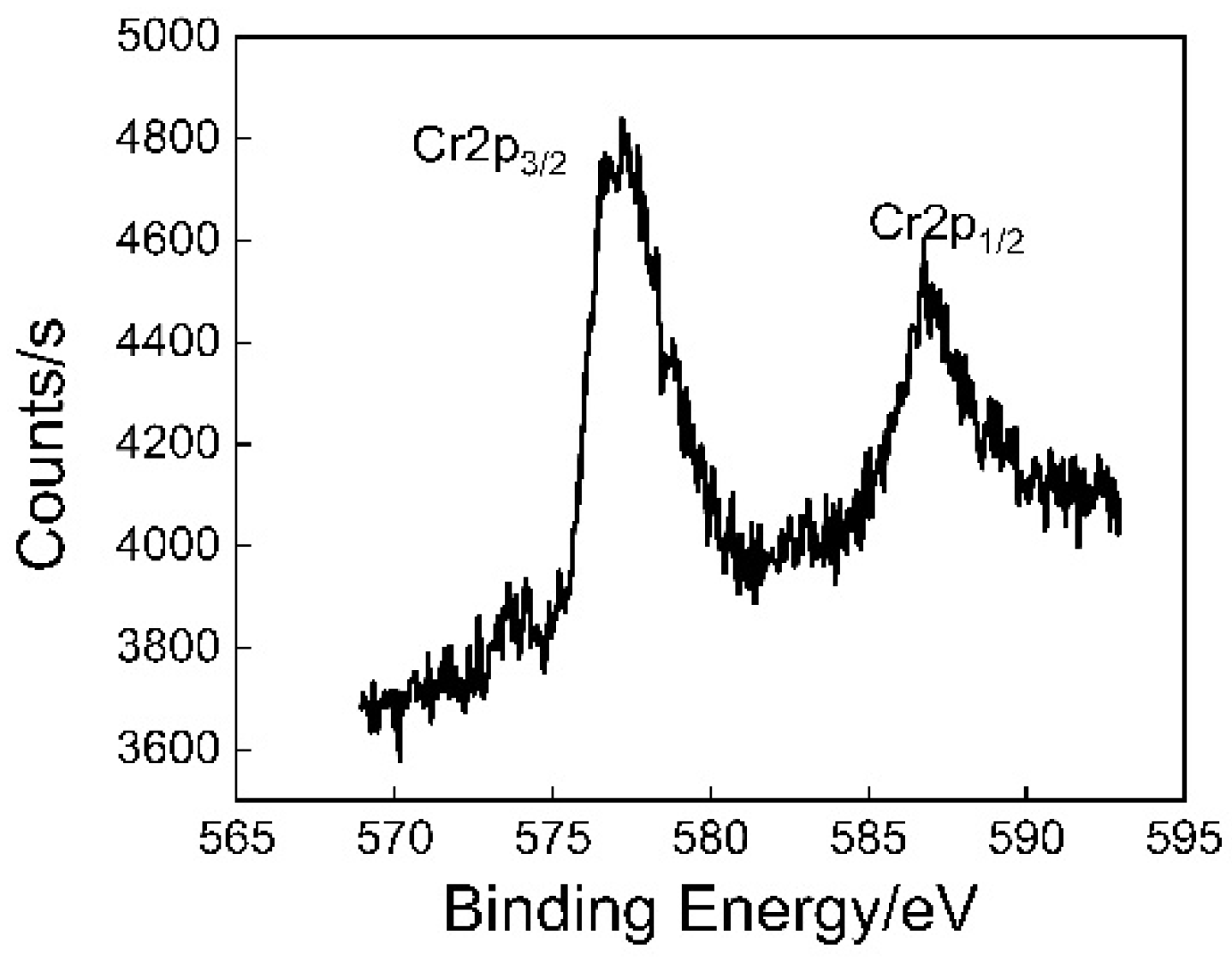





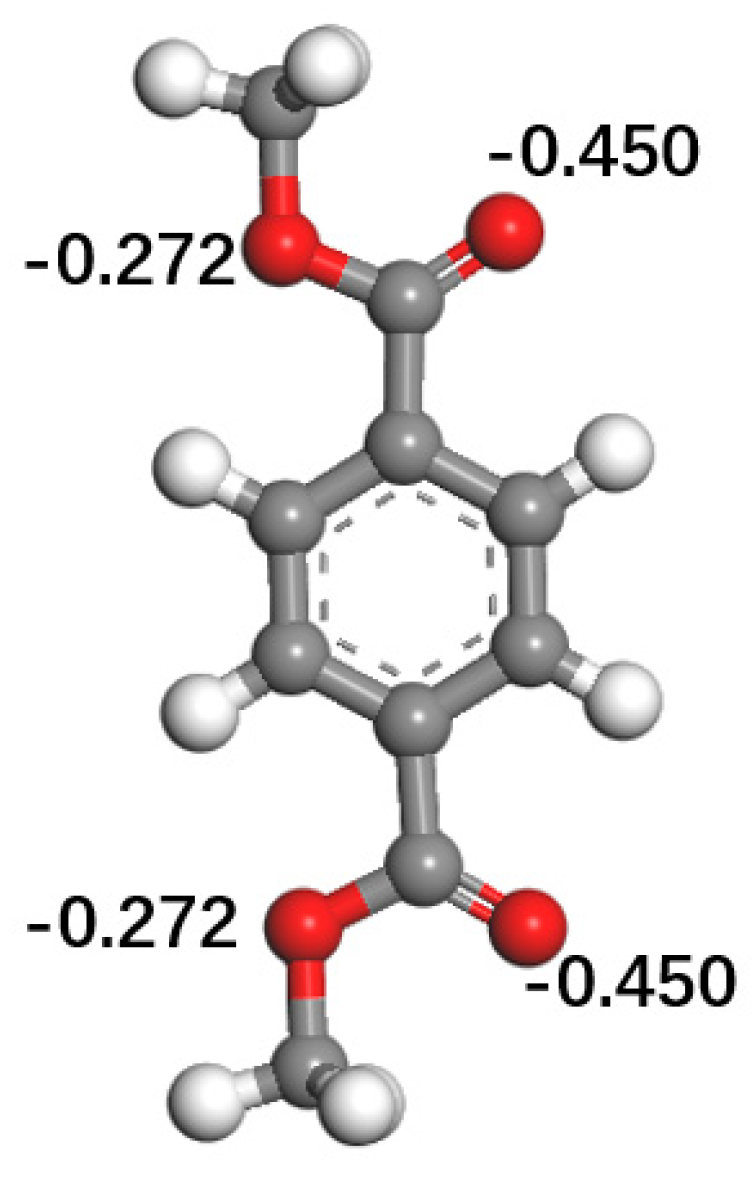
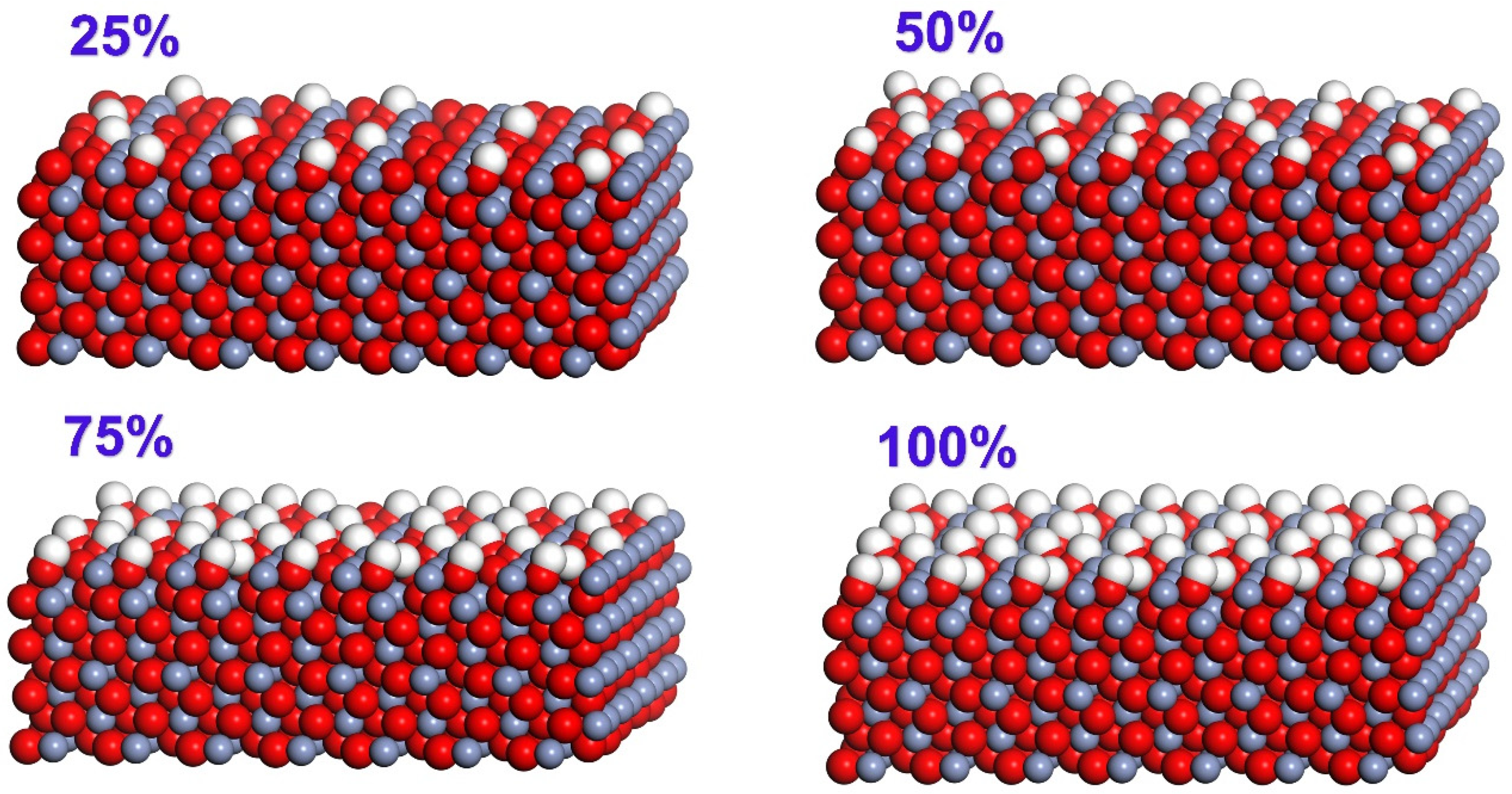

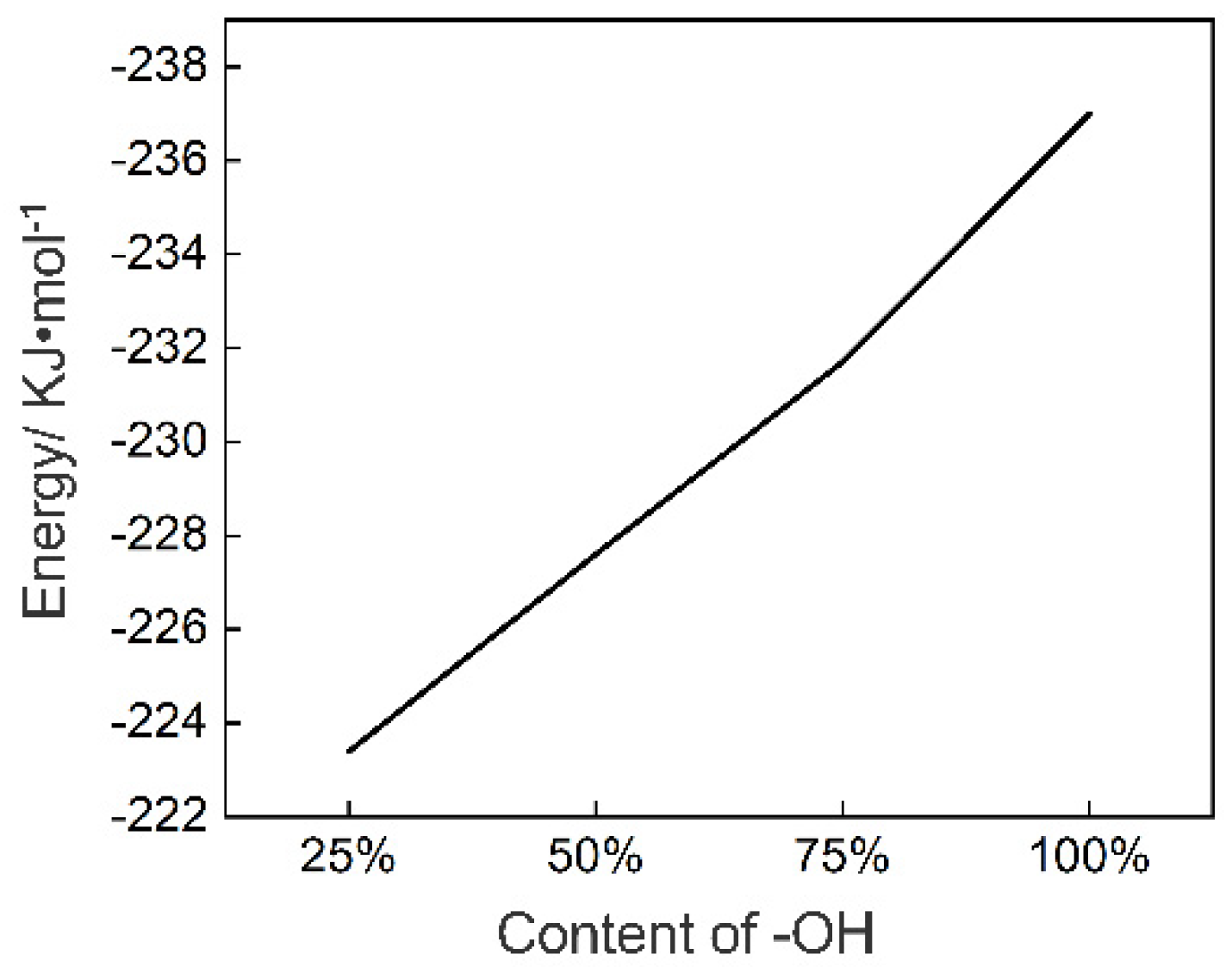
| Name | Peak BE | Atomic % |
|---|---|---|
| Cr2p | 577.07 | 0.76 |
| C1s | 284.82 | 83.52 |
| O1s | 532.09 | 13.72 |
| Name | Number | Binding Energies/eV | Compounds |
|---|---|---|---|
| Cr2p3/2 | b | 577.4 | Cr(OH)3 |
| Cr2p3/2 | a | 576.5 | Cr2O3 |
| Cr2p3/2 | c | 578.5 | CrO3 |
| Cr2p1/2 | e | 586.4 | Cr2O3 |
| Cr2p1/2 | d | 586.8 | Cr(OH)3 |
| (kJ/mol) | (kJ/mol) | (kJ/mol) | E (kJ/mol) | |
|---|---|---|---|---|
| Cr2O3 (200) | −620596.21 | −620616.96 | 83.86 | −63.10 |
| Cr2O3 (211) | −729577.13 | −729594.39 | 72.00 | −54.74 |
| Cr2O3 (110) | −663991.26 | −663826.00 | 136.21 | −301.47 |
Publisher’s Note: MDPI stays neutral with regard to jurisdictional claims in published maps and institutional affiliations. |
© 2020 by the authors. Licensee MDPI, Basel, Switzerland. This article is an open access article distributed under the terms and conditions of the Creative Commons Attribution (CC BY) license (http://creativecommons.org/licenses/by/4.0/).
Share and Cite
Liu, J.; Zhang, Q.; Zhang, B.; Yu, M. The Bonding Mechanism of the Micro-Interface of Polymer Coated Steel. Polymers 2020, 12, 3052. https://doi.org/10.3390/polym12123052
Liu J, Zhang Q, Zhang B, Yu M. The Bonding Mechanism of the Micro-Interface of Polymer Coated Steel. Polymers. 2020; 12(12):3052. https://doi.org/10.3390/polym12123052
Chicago/Turabian StyleLiu, Jiyang, Qingdong Zhang, Boyang Zhang, and Mingyang Yu. 2020. "The Bonding Mechanism of the Micro-Interface of Polymer Coated Steel" Polymers 12, no. 12: 3052. https://doi.org/10.3390/polym12123052




